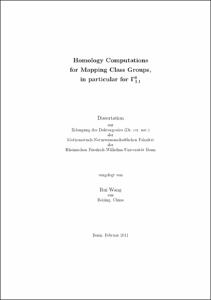Homology Computations for Mapping Class Groups, in particular for Γ03,1

Homology Computations for Mapping Class Groups, in particular for Γ03,1

| dc.contributor.advisor | Bödigheimer, Carl-Friedrich | |
| dc.contributor.author | Wang, Rui | |
| dc.date.accessioned | 2020-04-17T06:28:17Z | |
| dc.date.available | 2020-04-17T06:28:17Z | |
| dc.date.issued | 12.09.2011 | |
| dc.identifier.uri | https://hdl.handle.net/20.500.11811/5018 | |
| dc.description.abstract | In this thesis we compute the homology of mapping class groups of orientable and non-orientable surfaces. The surfaces we consider are of genus g, have one boundary curve and m permutable punctures. The corresponding moduli spaces $M_{g,1}^m$ in the orientable and $N_{g,1}^m$ in the non-orientable case are classifying spaces for the mapping class groups. We are able to compute the integral homology of the moduli spaces $M_{g,1}^m$ for h=2g+m<6 and of $N_{g,1}^m$ for h=g+m+1<5 (Note that we give a non-orientable surface the genus g if it is the connected sum of g+1 projective planes). For h=6 in the orientable case and h=5 in the non-orientable case (these are the cases $M_{3,1}^0$, $M_{2,1}^2$ and $M_{1,1}^4$ resp. $N^0_{4,1}$, $N^1_{3,1}$, $N^2_{2,1}$ and $N^3_{1,1}$) we can compute some p-torsion in the homology and the mod-p Betti numbers for several primes. But this is enough evidence to conjecture that we have indeed the entire integral homology in these cases, too. The computations are based on a cell structure of the moduli spaces. This cell structure is bi-simplicial and the associated chain complex $Q_{••}(h,m)$ resp. $NQ_{••}(h,m)$ can be described by parts of the classifying spaces of symmetric groups S2, ..., S2h resp. by parts of the classifying space of a category of pairings. Motivated by B. Visy's Dissertation, we investigate ways to simplify the homology computation for $M_{g,1}^m$ and $N_{g,1}^m$. On the one hand, we extend the notion of factorable groups to factorable categories and study the homology of the norm complex associated to a factorable category; moreover, similar to the fact that a symmetric group is factorable, we prove that the category of pairings is a factorable category. On the other hand, from the cell structures of $M_{g,1}^m$ and $N_{g,1}^m$ with their orientation systems, we construct the double complexes $\tilde{Q}_{••}(h,m)$ and $\tilde{NQ}_{••}(h,m)$ and study their homology. For the actual computations, we implemented the new algorithms in a computer program. | |
| dc.language.iso | eng | |
| dc.rights | In Copyright | |
| dc.rights.uri | http://rightsstatements.org/vocab/InC/1.0/ | |
| dc.subject.ddc | 510 Mathematik | |
| dc.title | Homology Computations for Mapping Class Groups, in particular for Γ03,1 | |
| dc.type | Dissertation oder Habilitation | |
| dc.publisher.name | Universitäts- und Landesbibliothek Bonn | |
| dc.publisher.location | Bonn | |
| dc.rights.accessRights | openAccess | |
| dc.identifier.urn | https://nbn-resolving.org/urn:nbn:de:hbz:5N-26108 | |
| ulbbn.pubtype | Erstveröffentlichung | |
| ulbbnediss.affiliation.name | Rheinische Friedrich-Wilhelms-Universität Bonn | |
| ulbbnediss.affiliation.location | Bonn | |
| ulbbnediss.thesis.level | Dissertation | |
| ulbbnediss.dissID | 2610 | |
| ulbbnediss.date.accepted | 01.07.2011 | |
| ulbbnediss.institute | Mathematisch-Naturwissenschaftliche Fakultät : Fachgruppe Mathematik / Mathematisches Institut | |
| ulbbnediss.fakultaet | Mathematisch-Naturwissenschaftliche Fakultät | |
| dc.contributor.coReferee | Franke, Jens |
Files in this item
This item appears in the following Collection(s)
-
E-Dissertationen (4075)




